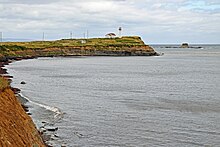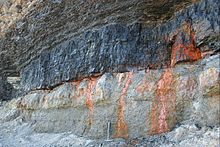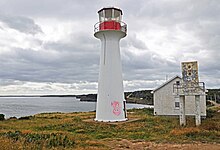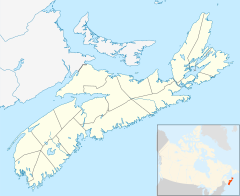Contents

Point Aconi (2021 pop. 113) is a rural community in Nova Scotia at the northeastern tip of Boularderie Island. It derives its name from the headland of the same name, Point Aconi.
Point Aconi is located in the Cape Breton Regional Municipality and fronts the Cabot Strait along the northeastern shore of Boularderie Island.
Demographics
In the 2021 Census of Population conducted by Statistics Canada, Point Aconi had a population of 113 living in 56 of its 59 total private dwellings, a change of -15.7% from its 2016 population of 134. With a land area of 10.11 km2 (3.90 sq mi), it had a population density of 11.2/km2 (28.9/sq mi) in 2021.[1]
Coal mining
The region sits over the northern end of the Sydney Coal Field, a large coal field which extends at an angle under the Cabot Strait. Specifically, the Point Aconi area is home to the Hub coal seam of the Sydney Mines Formation (Upper Carboniferous).

As such, the area around Point Aconi has been commercially mined since the early 19th century, first by the General Mining Association (GMA), then by the Nova Scotia Steel and Coal Company (SCOTIA) and later the British Empire Steel Corporation (BESCO) and its successors, the Dominion Steel and Coal Corporation (DOSCO) and the federal Crown corporation Cape Breton Development Corporation (DEVCO).
Point Aconi was home to the last underground coal mine in operation in Nova Scotia, the Prince Colliery, which was opened by DEVCO during the global energy crisis in the early 1970s. A limited access road, Highway 162, was constructed from the Trans-Canada Highway Highway 105 to the south in order to relieve local roads of traffic congestion during shift changes at the mine, as well as from dump trucks hauling the coal.
The then-provincial Crown corporation Nova Scotia Power Corp. constructed the Point Aconi Generating Station adjacent to the mine in the early 1990s to take advantage of the readily available fuel source.

The Prince mine was closed in November 2001, ending underground mining in Nova Scotia. However, the Point Aconi GS continues to operate as it is the most modern thermal generating station in Nova Scotia and provides lower emissions than older plants of a similar size.
Following the closure, several proposals were made to strip mine remaining coal deposits near the surface in the Point Aconi area. However, the proposal met with strong community opposition, citing fears of contamination and changes to groundwater supplies, as well as industrial nuisance through deteriorated air quality and noise which would lead to lower property values. Eventually, Pioneer Coal Limited was granted permission to conduct a reclamation mining operation starting in 2006.[2] By 2012, some 25% of the area had been reclaimed.[3]
Lighthouse
A lighthouse was first erected at Point Aconi in 1874. The last lighthouse, a glass fibre tower standing 11 metres (36 ft) tall, was erected in 1989. It was destroyed by fire in 2014.[4]
Climate
The highest temperature ever recorded in Point Aconi was 36.0 °C (96.8 °F) on 10 August 2001, and the coldest temperature ever recorded was −27.0 °C (−16.6 °F) on 8 February 1993.
| Climate data for Point Aconi Generating Station, 1981–2010 normals, extremes 1990–present | |||||||||||||
|---|---|---|---|---|---|---|---|---|---|---|---|---|---|
| Month | Jan | Feb | Mar | Apr | May | Jun | Jul | Aug | Sep | Oct | Nov | Dec | Year |
| Record high °C (°F) | 16.7 (62.1) |
17.1 (62.8) |
22.7 (72.9) |
24.7 (76.5) |
28.1 (82.6) |
33.1 (91.6) |
33.5 (92.3) |
36.0 (96.8) |
32.3 (90.1) |
26.8 (80.2) |
19.7 (67.5) |
17.6 (63.7) |
36.0 (96.8) |
| Mean daily maximum °C (°F) | −0.6 (30.9) |
−1.2 (29.8) |
2.1 (35.8) |
6.0 (42.8) |
12.9 (55.2) |
19.3 (66.7) |
23.4 (74.1) |
23.8 (74.8) |
19.6 (67.3) |
13.3 (55.9) |
7.3 (45.1) |
2.7 (36.9) |
10.7 (51.3) |
| Daily mean °C (°F) | −4.4 (24.1) |
−5.3 (22.5) |
−1.7 (28.9) |
2.5 (36.5) |
8.2 (46.8) |
14.2 (57.6) |
18.5 (65.3) |
19.2 (66.6) |
15.4 (59.7) |
9.6 (49.3) |
4.4 (39.9) |
−0.4 (31.3) |
6.7 (44.1) |
| Mean daily minimum °C (°F) | −8.2 (17.2) |
−9.4 (15.1) |
−5.4 (22.3) |
−1.0 (30.2) |
3.4 (38.1) |
9.0 (48.2) |
13.5 (56.3) |
14.5 (58.1) |
11.2 (52.2) |
5.9 (42.6) |
1.4 (34.5) |
−3.5 (25.7) |
2.6 (36.7) |
| Record low °C (°F) | −23.3 (−9.9) |
−27.0 (−16.6) |
−25.4 (−13.7) |
−13.0 (8.6) |
−6.0 (21.2) |
−2.0 (28.4) |
3.0 (37.4) |
4.3 (39.7) |
−0.6 (30.9) |
−4.1 (24.6) |
−7.7 (18.1) |
−21.0 (−5.8) |
−27.0 (−16.6) |
| Average precipitation mm (inches) | 127.6 (5.02) |
113.8 (4.48) |
131.6 (5.18) |
117.5 (4.63) |
103.6 (4.08) |
70.1 (2.76) |
98.1 (3.86) |
74.3 (2.93) |
119.5 (4.70) |
155.0 (6.10) |
132.8 (5.23) |
137.7 (5.42) |
1,381.4 (54.39) |
| Average rainfall mm (inches) | 72.0 (2.83) |
60.2 (2.37) |
93.0 (3.66) |
91.7 (3.61) |
103.3 (4.07) |
70.1 (2.76) |
98.1 (3.86) |
74.3 (2.93) |
119.5 (4.70) |
155.0 (6.10) |
127.0 (5.00) |
103.4 (4.07) |
1,164.4 (45.84) |
| Average snowfall cm (inches) | 55.6 (21.9) |
53.6 (21.1) |
38.6 (15.2) |
25.8 (10.2) |
0.3 (0.1) |
0.0 (0.0) |
0.0 (0.0) |
0.0 (0.0) |
0.0 (0.0) |
0.0 (0.0) |
5.8 (2.3) |
34.3 (13.5) |
214.0 (84.3) |
| Source 1: Environment Canada[5] | |||||||||||||
| Source 2: Weatherbase[6] | |||||||||||||
References
- ^ "Population and dwelling counts: Canada and designated places". Statistics Canada. February 9, 2022. Retrieved May 9, 2022.
- ^ Noble, Russell (1 May 2010). "Coal mine fits right in with the community". Canadian Mining Journal. Retrieved 24 August 2018.
- ^ Collins, J. (11 February 2012). "C.B. could see more surface mining operations in its future". Cape Breton Post. SaltWire Network. Retrieved 24 August 2018.
- ^ Patterson, Elizabeth (24 February 2014). "End of an era as Point Aconi lighthouse mysteriously destroyed". Cape Breton Post. SaltWire Network. Retrieved 24 August 2018.
- ^ "Point Aconi". Canadian Climate Data. Environment Canada. Retrieved 30 April 2016.[permanent dead link]
- ^ "Point Aconi, Nova Scotia". Weatherbase. Weatherbase. Retrieved 27 December 2015.


